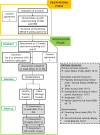Early intervention at home in infants with congenital brain lesion with CareToy revised: a RCT protocol
- PMID: 30185165
- PMCID: PMC6126039
- DOI: 10.1186/s12887-018-1264-y
Early intervention at home in infants with congenital brain lesion with CareToy revised: a RCT protocol
Abstract
Background: Congenital brain lesions expose infants to be at high-risk for being affected by neurodevelopmental disorders such as cerebral palsy (CP). Early interventions programs can significantly impact and improve their neurodevelopment. Recently, in the framework of the European CareToy (CT) Project ( www.caretoy.eu ), a new medical device has been created to deliver an early, intensive, customized, intervention program, carried out at home by parents but remotely managed by expert and trained clinicians. Reviewing results of previous studies on preterm infants without congenital brain lesion, the CT platform has been revised and a new system created (CT-R). This study describes the protocol of a randomised controlled trial (RCT) aimed to evaluate, in a sample of infants at high-risk for CP, the efficacy of CT-R intervention compared to the Infant Massage (IM) intervention.
Methods/design: This RCT will be multi-centre, paired and evaluator-blinded. Eligible subjects will be preterm or full-term infants with brain lesions, in first year of age with predefined specific gross motor abilities. Recruited infants will be randomized into CT-R and IM groups at baseline (T0). Based on allocation, infants will perform an 8-week programme of personalized CareToy activities or Infant Massage. The primary outcome measure will be the Infant Motor Profile. On the basis of power calculation, it will require a sample size of 42 infants. Moreover, Peabody Developmental Motor Scales-Second Edition, Teller Acuity Cards, standardized video-recordings of parent-infant interaction and wearable sensors (Actigraphs) will be included as secondary outcome measures. Finally, parents will fill out questionnaires (Bayley Social-Emotional, Parents Stress Index). All outcome measures will be carried out at the beginning (T0) and at end of 8-weeks intervention period, primary endpoint (T1). Primary outcome and some secondary outcomes will be carried out also after 2 months from T1 and at 18 months of age (T2 and T3, respectively). The Bayley Cognitive subscale will be used as additional assessment at T3.
Discussion: This study protocol paper is the first study aimed to test CT-R system in infants at high-risk for CP. This paper will present the scientific background and trial methodology.
Trial registration: NCT03211533 and NCT03234959 ( www.clinicaltrials.gov ).
Keywords: Cerebral palsy; Early intervention; High-risk infants; Infant massage; Information and communication technology; Neurodevelopmental bioengineering; Randomized clinical trial; Tele-rehabilitation.
Conflict of interest statement
Authors’ information
GS is child neurologist and researcher at University of Pisa and at IRCCS Fondazione Stella Maris. EB is paediatric physical therapist at IRCCS Fondazione Stella Maris. MG is neonatologist involved in follow-up program at Neonatology Unit of Pisa University Hospital (AOUP). RR is child neuropsychiatrist involved in the follow-up program at University Children’s Hospital “A. Meyer” in Florence. GC is full professor of child neuropsychiatry at University of Pisa and Scientific Director of IRCCS Fondazione Stella Maris.
Ethics approval and consent to participate
Tuscan Region Paediatric Ethics Committee (Italy) approved the present study (no. 84/2017). After receiving verbal and written informative material concerning the trial, eligible parents will be asked to fill out two informed consent forms at the start each of the two trial phases. The first one is relative to the observation phase while the second one to the intervention phase. The latter will be provided only to parents of non-fidgety infants. Both consent forms will be signed by parents or legal representative of eligible infants.
Consent for publication
Not applicable.
Competing interests
The authors declare that they have no competing interests.
Publisher’s Note
Springer Nature remains neutral with regard to jurisdictional claims in published maps and institutional affiliations.
References
-
- Behrman RE, Butler AS. Preterm Birth: Causes, Consequences, and Prevention. Washington (DC): National Academies Press (US); 2007. - PubMed
-
- Cioni G, Sgandurra G, Muzzini S, Paolicelli PB, Ferrari A. Forms of Hemiplegia. The Spastic Forms of Cerebral Palsy: A Guide to the Assessment of Adaptive Functions. Milano: Springer Milan; 2010. pp. 331–356.
Publication types
MeSH terms
Associated data
LinkOut - more resources
Full Text Sources
Other Literature Sources
Medical
Miscellaneous


